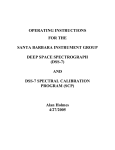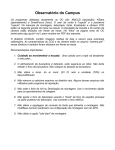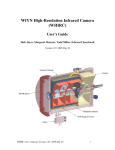Download OPERATING INSTRUCTIONS FOR THE SANTA BARBARA
Transcript
OPERATING INSTRUCTIONS FOR THE SANTA BARBARA INSTRUMENT GROUP SELF GUIDED SPECTROGRAPH (SGS) AND SPECTRA ANALYSIS SOFTWARE Alan Holmes 3/30/2001 1 SBIG Self Guided Spectrograph (SGS) Operating Instructions Alan Holmes 3/30/01 1.0 - Overview: this document describes the operation of SBIG’s self guided spectrograph and the installation and use of our analysis software. This instrument has been optimized to capture stellar spectra with high resolution, but has enough sensitivity and flexibility to allow its use on brighter galaxies and emission nebula. This unit is a scientific instrument: we expended considerable effort in making collection of the spectra easy, but you will find that a good spectrum of an object requires significant care and effort. Analysis of the data for astronomical meaning is beyond the scope of this document. SBIG’s expertise is in the hardware, not the astronomy, so we will not be able to provide much help with data interpretation beyond the basics. To use the spectrograph you must first align it to your camera, and go through some initial calibration steps. This will help familiarize you with the product. Safety Warning: if you use calibration lamps such as a mercury PenRay that emits short wave UV (at around 2537 Angstroms, or 253.7 nM), be very careful with corneal and skin sunburn from the lamps. The little mercury PenRays (such as an Edmund H40759) with quartz envelopes, held one foot from your face for five minutes, will put you in the hospital. They do not appear that bright, but the UV emission is tremendous. Even one minute will give you a sunburn and scratchy, dry feeling eyes. I have personally suffered the effects of exposure to these sources twice, and have had two coworkers (separate incidents) requiring bandaging of their eyes after exposure. The SBIG spectrometer has an order sorter that blocks these wavelengths from the system, so long wave mercury sources are adequate. I have no experience with how safe these are, so take precautions. Fragility warning: All of the optics in the SGS can be cleaned with isopropyl alcohol and cotton swabs except for the gratings. The grating surfaces should never be touched. The groove structure is easily damaged. If they are dusty, blow them off with light air flow. A little dust will not bother your spectra at all, but cleaning can easily do much greater damage. 2.0 - SGS Description: the spectrograph is designed to operate with the ST-7/8/9. The object that is to be analyzed is viewed on the tracking CCD, simultaneously with the slit. The slit is backlit by an LED during object acquisition to render it clearly visible on the tracking CCD. The object is manually maneuvered onto the slit using the telescope controls, and is held there using our patented self guiding feature during a long exposure. The spectra is recorded by the imaging CCD, oriented long-ways so the spectra falls across 765 pixels, with a height of about 8 pixels for stellar sources. Two gratings are available. The standard grating, 150 rulings per mm, gives a dispersion of 4.3 angstroms per pixel, and allows the user to capture the entire interesting range from the calcium H and K lines to H-Alpha with a single exposure. The resolution is about 8 angstroms. A 2 high resolution grating on a carousel in the instrument can also be used that gives 1.07 angstrom per pixel dispersion, with a resolution of about 2.2 angstroms. The spectral range is smaller, being only about 750 angstroms. This resolution is adequate to detect the doppler shift due to the earth’s motion around the sun when carefully calibrated, and detect spectroscopic binaries. Two slits are provided with the unit. The slit installed at SBIG is 25 microns wide, but it appears to be 18 microns wide to the spectrograph since it is tilted. A wider slit, 100 microns wide, is included with the spectrograph for use in capturing the spectra of dim extended objects, such as galaxies. It appears to be 72 microns wide. It is more effective on dim objects since more light makes it through the slit, but at the cost of spectral resolution. 3.0 SGS Specifications: Dispersion: 1.07 or 4.3 Angstroms per pixel Resolution: emission line is recorded with 2.2 or 8 Angstrom Full Width at Half Maximum Spectral coverage per frame: about 750 Angstroms with the high resolution grating, or 3200 Angstroms with the low resolution grating Center Wavelength Selection: Calibrated Micrometer Adjustment Wavelength Range: 3800 to 7500 Angstroms Sensitivity: Signal to noise ratio of 10:1 for a 10th Mag star, 20 minute exposure using an ST-7E and a 10 inch (25 cm) aperture in high resolution mode. An ABG ST-7 will reach magnitude 8. The low resolution mode with the wide slit will be 2 magnitudes more sensitive Entrance Slit: 18 micron (2.3 arcseconds wide with 63 inch (160 cm) focal length Telescope Acceptance Angle: F/6.3 by F/10. F/6.3 recommended for maximum signal. Dimensions: 4 x 5 x 8 inches (10 x 12 x 20 cm) Weight: spectrograph plus ST-7 weigh 5.2 pounds (2.4 kg) Uses: Stellar Classification Analysis of Nebular Lines Identification of spectroscopic binaries Measurement of Stellar proper motion to +/- 6 km/sec accuracy Measurement of Emission Nebula Proper Motions Spectra of Laboratory and field sources 3 Galactic Spectra and Red Shift Measurement of Brighter Quasars Galactic Red Shifts and Spectra: Difficult to obtain due to faintness, extended nature of source, and lack of high contrast emission lines. Only the brighter galaxies can be measured. Seyfert galaxies which have excess H-alpha emission are much easier to measure. 4.0 Initial Alignment - All SGS units that are shipped from SBIG have been aligned to an ST-7 camera here, so they should be pretty close. If you find during one of the following steps that the system appears to be seriously misaligned, make sure no optical elements have come loose and that you are following the procedure correctly. Step 1 – Attach Coupling: remove the D-block from the front of your ST-7 or ST-8. Using the four screws provided, attach the spectrograph coupling to the ST-7 as illustrated in Figure One. It is important to orient the coupling as shown, with the thick part to the left. Figure One:ST-7 with Attached Coupling – Note Orientation Spectrograph Coupling Step 2 – Attach camera to Spectrograph: remove the cover on the spectrograph by removing the four Phillips Head screws around the periphery of the baseplate. Loosen the clamp where the camera attaches, and insert the tube on the coupling. Lay the camera 4 on its back when retightening the clamp to insure that the camera is fully seated. The camera should be oriented so the exiting cables point away from the end of the spectrograph with the toggle switch. Figure Two labels the important SGS alignment points. Note: if you are using an ST-8 you will need to reposition the clamp plate to the other set of holes in the baseplate. This will maintain the tracking CCD at the original position, but move the imaging CCD over. Due to the larger size of the imaging CCD, the spectra will still fall upon it. Figure Two: Important Alignment Points Telescope Coupling Focus Achromat Spherical Mirror Grating Toggle Second Fold Mirror Camera Clamp Grating Lever Micrometer Screw Step 3 – Adjust slit focus: slip the cover back on, without the screws (you get to do this a lot), and connect the camera to your computer. Power it up, and run CCDOPS. With the assembly just sitting on the table, select FOCUS mode with the tracking CCD and adjust the room light so you can see the slit with a 1 second exposure. Power up the internal LED by flipping on the toggle switch. The slit should be approximately vertical, and in the center third of the tracking CCD. In this step, you should adjust the slit focus to be sharp – do not worry about the orientation to the CCD grid. Make sure the flag on top of the cover is oriented so as to let the light go by. When you can see the slit image, adjust the focus by removing the cover, loosening the focus achromat, moving it slightly, retightening it, and reinstalling the cover. Continue with this process until the slit image is sharp (1 to 2 pixels wide). This 5 is tedious, but need only be done once. The image file on the software disk, M57TRACK.ST7, shows what an acceptable focus looks like. Step 4 – Adjust slit image position: to center the slit on the tracking CCD, loosen the second fold mirror, rotate it slightly, retighten it, replace the cover and view the image. The adjustment is coarse. Once again, this is a tedious process. If the slit image is on the center third of the tracking CCD you are done. This completes tracking CCD adjustments. Step 5 – Find spectral lines: set the assembly on the table, resting on the handles. Tape a piece of paper over the telescope coupling, and illuminate it with a fluorescent lamp or a neon lamp. Choose the low resolution grating by rotating the toggle to point up (away from the handles) until it snaps into the detents. Set the micrometer screw to 5.44 mm (which should put the mercury 5461 angstrom line near the center). Orient the flag on top to block the tracking path since the light flood-illuminates the slit. In CCDOPS set the CCD to imaging, the resolution mode to 1xN, and the vertical binning to 4 pixels. Use focus mode with the imaging CCD, 1 second exposures, and you should see spectral lines. The cameras are shipped with the low resolution grating in position. Refer to Figure Three for identification of the most prominent spectral lines for mercury and neon. Figure Three: SPECTRA program Illustration of Spectral Lines (Low Dispersion) 6680 6403 5851 Neon Mercury 5770 & 5791 4358 5461 4046 Note: the camera can have very significant stray light when used this way, since very little light goes through the slit: most bounces off the reflective surface and ends up on the tracking CCD, where it can scatter to the imaging CCD. Astronomically this is only a problem when doing the moon or sun – all other sources are fairly small. Fortunately, the sun and moon do not need self guiding! This is the purpose for the flag on top of the cover. If self-guiding is not needed (generally for a spatially large source) block the tracking path. Step 6 – Rotate camera: Once you have spectra, switch to the high resolution grating and center a bright line. In the high resolution mode the spectral line should be nearly centered when the dial reads the wavelength. For example, a dial reading of 5.46 mm should position the 5461 angstrom line on the CCD. The dial reading is not perfect in the high resolution mode, but its good enough to find isolated spectral lines. The vertical binning really accentuates the slant of the spectral lines, but the slant is easily removed. Remove the cover, loosen the camera coupling and rotate the camera slightly, retighten the coupling, and slip the cover back on. We recommend you lay the 6 camera on its back while doing this to ensure the camera is seated. Repeat this process until the spectral lines are vertical to within a pixel, which is not that hard. Don’t worry about momentarily blocking the fan while tightening the clamp – no harm will be done. Note: we align the spectrograph at SBIG such that when the spectral lines are vertical in the high resolution mode, a stellar spectra will be horizontal to an accuracy of a few pixels. This is only true in the high resolution mode. If you switch to the low resolution mode the stellar spectra will still be horizontal, but the calibration lines will tilt to the right about 15 pixels, top to bottom. At this point you have a choice. If you wish to work in low resolution mode you can live with the tilt, but calibrate on exactly the same strip that the star falls upon. This is recommended in practice. Or, you can rotate the camera to make the calibration lines vertical, and live with the tilt of the stellar spectra which, if you are binning 4:1, isn’t too bad. If the source is an extended object this is not much of a problem. The inability to perfectly square up stellar spectra with calibration lines is a consequence of the optical design. We have rotated the slit slightly off horizontal to minimize this effect for the high resolution grating, assuming that the most critical wavelength position determination will be done with this grating. Step 7 – Focus the Spectrograph: Reach underneath the spectrograph and loosen the screw that clamps the spherical mirror assembly down. While viewing a bright, centered line using CCDOPS, focus the spectrograph using the focus screw, which translates the mirror toward or away from the grating. When satisfied with the focus retighten the mirror clamp screw. Check again. Clamping the screw shifts the focus slightly so, when you get close, you may need to clamp each time you move the mirror. Both gratings focus at the same point. Since the design uses only mirrors, all lines are in focus. Step 8 – Calibrate the micrometer: Find the bright mercury line at 5460.7 angstroms and center it on the imaging CCD using CCDOPS. Switch to the high resolution grating by flipping the grating lever to where it points toward the handles. You should feel the detent as the grating snaps into place. Adjust the micrometer to read 5.46 mm. Using the adjustment screw on the grating lever, adjust the grating angle to where the 5460.7 nm line is recentered. Once again, this is tedious since the cover has to be repeatedly removed and replaced. Once adjusted, tighten down the locknut on the adjustment screw. Try finding other lines by dialing the micrometer. While the micrometer accuracy is not perfect, it enables you to rapidly find a spectral region. When the low resolution grating is used, we recommend you construct a simple calibration table of center wavelength as a function of micrometer reading (using known spectral lines) to aid you in positioning the grating. As an aid, the following table shows where the common mercury lines will be found with the low resolution grating when the high resolution grating is calibrated. Line 4046 A 4358 5461 5770&5791 Micrometer 5.10 5.15 5.44 5.52 7 Step 9 – Finish: tighten all screws, and replace the cover. You may find that long exposures require you to seal the joints with black electrician’s tape to prevent light leaks, depending on the light level in your observatory. Light leaks are most likely to occur around the camera-spectrograph connection, on the bottom side of the spectrograph. Make sure you leave the internal LED off during a long exposure (I guarantee you’ll forget at least once)! Optional step – Installation of the wider slit: remove the cover, and locate the slit assembly. Remove the LED bracket from the slit, and set it down out of the way inside the unit. Remove the two slit mounting screws while holding the end of the slit plate, remove the slit, and install the wider slit plate. (It is easy to identify the wider slit by holding it up to a light). Press the slit plate toward the baseplate when finally tightening the screws to preserve the factory alignment. Make sure the aperture side of the slit faces the telescope. Re-attach the LED bracket. Re-install the cover. No other alignment of the unit should be necessary except, of course, the wavelength calibration. It will only change slightly. 5.0 Use of the Spectrograph If you are new to using the ST-7/8 camera we suggest you refer to its manual and have a few practice sessions using it as an imager before attempting collecting spectra. To collect a spectrum of an object, first position the telescope to place the object on the tracking CCD using CCDOPS. Turn on the internal LED to backlight the slit and position the object onto the slit. The LED brightness can be adjusted by turning the potentiometer shaft. For bright stars, you will see multiple images, displaced horizontally. This occurs at the slit. It can be hard to recognize which image is the main one since CCDOPS auto-contrasts the images. If in doubt, broaden the range of the display contrast, and then the brightest image is obvious. When the object is placed on the slit, go to the camera setup menu, and select the imaging CCD, 1xN resolution, and a vertical binning of 1x4 (for stars) or 1x8 (for dim extended objects). Immediately start a self-guided exposure with the desired exposures set for tracking and imaging CCDs. When the first image appears select the star, view the image to make sure the object is still on the slit, carefully turn off the LED back-light, and start the exposure. Save the image when done. Positioning the object on the slit can be tricky. The CCDOPS for DOS software has an option when beginning self-guiding to track-to-the-cursor or to-the-centroid of the star. Tracking to the cursor enables the user to reposition the star slightly to straddle the slit. CCDOPS for Windows may have this feature also by the time the user acquires the spectrograph. You will need to take darks just as for imaging, captured using the same vertical binning as the spectra. The darks are more critical, since there is very little sky background when doing spectroscopy, and the noise in the image is dominated by the dark current. In long exposures cosmic rays are a nuisance, leaving bright pixels in the light images and dark 8 streaks if in your darks. SBIG has received much criticism that our temperature stabilization is faulty and the darks taken on separate nights do not subtract well. I have investigated this problem and found that darks on separate nights indeed do not subtract well, but it is not a temperature stabilization problem. It is as if something changes in the CCD slowly over time, and does not repeat over long periods. I recommend the user plan on taking long darks to match the exposures on the same night the spectra are collected. This will give the best results. Libraries of darks do not work well. To collect a calibration spectra, position the calibration lamp to illuminate the opal diffuser on the bottom of the spectrograph and take an exposure long enough to get at least a few hundred counts of signal in each line. You should do this either directly before or after capturing the astronomical spectra, without removing the spectrograph from the telescope or disturbing it significantly. We have tried to make a very solid unit, but measuring line position to an accuracy of fractions of a pixel requires great care. For very critical work, such as measuring doppler shifts with high accuracy, we recommend you collect the calibration data simultaneously with the astronomical data. This is done by placing the light source several feet away from the diffuser, and leaving it on during the exposure. A fluorescent lamp will not work for this technique since there is so much continuum. You will need either a mercury or neon lamp. The biggest problem is not scale changes, where the dispersion of the system in angstroms per pixel changes during an exposure, but simple shifts. For this reason neon lines, even though they are inconveniently placed in the yellow and red, are useful. After the exposure one can use a fluorescent lamp to measure the scale factor. Try to position the spectral region under observation such that one can obtain at least two calibration lines. There is no perfect calibration source commercially available. Small neon indicator lamps positioned close to the diffuser work well for the red and yellow end of the spectra, but have nothing in the green and blue. Mercury (which is used in fluorescent lights) is the best easily available lamp source for this region. If your site is significantly light polluted you will see mercury and sodium lines in long exposure data, along with an airglow line at 5577 angstroms. Sodium absorption lines in galaxies are very useful for doing red shifts, so sodium lines in the sky background are quite annoying. The analysis software enables one to remove the bulk of the light pollution signal from the data. 6.0 Use of the Analysis Software SBIG’s WINDOWS 95/98 analysis software enables one to view the collected spectra graphically, to calibrate the spectra, to print out graphical data, and to produce text files with the raw data annotated with wavelength data. These text files can be viewed with popular spreadsheet programs, which have more powerful graphing capability. The calibration that is performed is a best fit to the grating equation using two lines, and is good to about 0.1 pixel with adequate signal. To install the software, install the floppy disk labeled DISK 1 into your PC, and run the setup program. The setup utility will install the program and some sample files. 9 If you run the program you will see the user screen shown in Figure 4. You should begin by loading a calibration spectra. Start by clicking on the LOAD CAL button, and load the MERC.ST7 spectra. This spectra was obtained by capturing a mercury spectrum in low resolution mode. The SBIG Spectra program will only load files that are less than 768 pixels wide and exactly 20 pixels tall, so the data was cropped to that shape. Next, click LOAD DATA and load the NEON.ST7 data. Reselect the calibration data by clicking the GRAPH CAL button. Once the data is loaded you can click the ADJUST CONTRAST button to bring up a dialog box that allows you to modify the background and range with which the image is displayed. The analysis program uses the values that were saved with the image, so if you get in the habit of adjusting the appearance before first saving the image you will save time. Using the long horizontal scroll bar underneath the graph, move the red tick between the two spectral strips over to the line at 5460.7 nm (refer to Figure 3). You can move the tick by either clicking on the ends of the scroll bar, or putting the mouse on the slider between them, holding down the left button, and dragging it back and forth. Center the spectral line between the two vertical lines on the graph. These two vertical lines should be spaced to comfortably enclose 95% of the signal in the spectral line, but not so far apart that neighboring spectral lines are included. The line spacing can be changed using the SELECT WIDTH OF REGION control on the right side of the screen. Click the down arrow, and choose the desired width from the options by clicking on it. The line spacing should change on the graph. Five pixels wide is a good choice for the example. With the 5460.7 nm spectral line centered, click MARK LINE 1. The software will then find the centroid of the spectral line to accurately determine its position. Next, move the red tick mark to center the line at 4358.337 nm. Use the IDENTIFY SPECTRAL LINE control to select 4358.337 nm. Click MARK LINE 2. The software will complete the calibration and display the calculated focal length of the spherical mirror in the spectrograph, and the spectral dispersion across the CCD in angstroms per pixel. The dispersion is an approximation – the software uses the grating equation every time it calculates a wavelength to minimize calculation errors. The focal length is about 140 mm, and the dispersion 480 angstroms per mm (ignore the sign). You are now ready to measure a spectra. Click the GRAPH DATA to look at the neon data. Move the red tick over to a line, center the line, use the CALCULATE LINE WAVELENGTH control to view the line’s wavelength (this control uses the centroid of the data for accurate results). If the value is slightly off, select the correct wavelength from the IDENTIFY SPECTRAL LINE box, and hit MARK LINE ONE. Since the program has an active calibration it keeps the focal length parameter from before, and adjusts the grating angle to compensate for the slightly different position in the neon spectra. Now, move the red tick mark over to the other spectral lines visible in the ring nebula image, center them, and click CALCULATE LINE WAVELENGTH on the left side of the screen. The software will find the centroid of each line, and use the grating equation to find the true wavelength. Note that the border around the upper strip image is red. Click the GRAPH CAL button to bring the calibration data back to the graph. Now if you center a line in the 10 graph, and click CALCULATE LINE WAVELENGTH you will see the center wavelength of a feature in the calibration data. The calibration will still use the 5460.1 nm line centroid value from the neon data, though, so you need to recenter the 5460.7 nm line in the calibration data, and click MARK LINE 1 again. The CALCULATE LINE WAVELENGTH button works with absorption features also. The software first looks to see if the center pixel is less than or greater than the pixels marked by the lines to determine if it is an absorption feature or emission feature, respectively, and then calculates the centroid appropriately. The LINEAR GRAPH, LOG GRAPH, AUTOSCALED GRAPH, and PUSHED GRAPH all affect the way the data is graphed in the graph box. For LINEAR GRAPH the data is simply scaled from the minimum to the maximum of the data set. For LOG GRAPH each factor of 10 in counts is scaled to one quarter of the graph box’s range. For AUTOSCALED GRAPH, which is the most useful, the data is linearly scaled from the maximum to the minimum of the portion of the spectrum within the graph box. For PUSHED GRAPH the data is shown at maximum scale so features down in the noise can be seen. If you check the SMOOTHING ON box, the graph will be smoothed for display purposes. If you click EXPAND SPECTRA, the gray scale display for both data and calibration spectra will be displayed expanded vertically. Any slope in the lines is removed, and faint features (real or not!) are more easily seen. If a calibration is active, the displays will be shown in color, matched to the spectral data. Controls for cropping the calibration and data spectra are contained in the lower right and left corners of the screen. If these controls are left at their default, 1 to 20, then all 20 pixels in a column are summed and that data used for all calculations. You can adjust the crop box to include only that portion of the spectra which contains stellar data. This is a convenient feature. For example, collect some data on a star or nebula with the calibration source on during the exposure. Crop the data to 768x20 and resave it. Load the file into both the calibration and data spectra screens. Crop the CALIBRATION data to just include the calibration lines above the object’s spectra, and crop the DATA spectra to just include the object. Cropping is useful when the calibration data is captured at the same time as the astronomical data, such as this. It can also improve the signal to noise when very faint stars are being observed, when including all 20 pixels in a column when only 4 have signal will increase the noise. Note – when moving the crop limits, the display takes several seconds to update. The FILTER AIRGLOW control can be used when the crop lines are moved off the boundaries into the body of the strip. It subtracts off the airglow, based on what is above or below the crop box. The USE MEDIAN control reduces noise by applying a median filter to the data. The median filter works well since the noise is mostly “hot pixel” in appearance. To print out a graph of the spectrum for annotation or future reference, click the PRINT GRAPH button. To write a text file containing the sum of the signal between the crop lines, use the WRITE TEXT FILE button. The file created will be saved in the same directory as the original file, with a .TXT extension. If a calibration is active the wavelength data will be shown for each pixel. This text file can be opened with Microsoft Excel or other spreadsheet programs. The data saved will be for the active strip. 11 The SAVE STRIP FILE command creates a .ST7 file of the expanded spectra for processing by CCDOPS with the intent of creating a publishable illustration. One can also sample the screen image at any time by hitting the ALT-PRINT SCREEN keys on the PC keyboard, which copies a bitmap of the screen into the clipboard. One can then PASTE the image into PAINT, or other programs, where it can be manipulated. If you need to calibrate using spectral lines that are not part of the list, please use the MANUAL ENTRY option at the bottom of the spectral line list. Then enter the wavelength of the calibration line in Angstroms in the dialog box that pops up. Version 1.2 of the SPECTRA software should read ST-7/8/9/10 images up to 768 pixels wide and 20 pixels tall. Users with ST-8s and ST-10s should compress their images 2x2 and crop them, if necessary. The software should correctly account for the larger pixel size of a binned image. 7.0 Collecting Astronomical Spectra To gain experience with the device and the software, we recommend you start out measuring some bright stars in both low resolution and high resolution mode, and some bright nebulas in low resolution mode. With the stars you will find that red stars, such as Betelgeuse, Arcturus, and Antares have copious spectral lines. These lines need the high resolution mode to fully resolve them. Easily identified lines are the magnesium triplet at 5167.328, 5172.698, and 5183.619 A, and the sodium doublet at 5889.973 and 5895.940 A. Bright blue stars, such as Sirius, Vega and such have much less distinct lines, but have broad absorption features around H-alpha (6562.808 A), H-beta (4861.342 A) and H-gamma (4340.475 A). Note that the breadth of these features is different between stars of different temperatures. Stars with hotter coronas have broader features (Doppler broadening). With nebular data, you should have no problem finding H-alpha, H-beta, and atomic oxygen (5007 A) lines. Faint diffuse objects are easy if the spectrum is composed of emission lines. For a greater challenge, try measuring the orbital velocity of the earth by looking at stellar data with high resolution. The Doppler shift is only about a pixel, so the measurement requires care. You can find published data on stellar velocities in a number of publications (such as Astrophysics Quantities). Trying to match published data with stellar data from stars in different parts of the sky will reveal the motion. The correct answer is that the earth is moving at 30 kilometers per second in its orbit. If you stand outside at sunset, and look toward the celestial equator in the south, you are moving AWAY from what you see, and the lines will be shifted to the red. Note – the movement is not directly toward the celestial equator, since that is defined by the rotation axis of the earth, not the axis of the earth’s rotation around the sun. The red shift of a spectral line in angstroms is well approximated by the following equation: Red shift = Z = (wavelength observed-wavelength actual)/(wavelength actual) Z = velocity/C, where C = 300000 km per second (for non-relativistic speeds) 12 Objects moving away from you are shifted to the red. Our position in the spiral arm of the Milky Way results in a 215 km per second imposed on objects outside the galaxy, depending on their direction relative to the galactic equator (which is quite tilted relative to the celestial equator). Velocities of remote galaxies are sometimes given relative to the center of the Milky Way, so use reference publications carefully. When you are comfortable with the unit, you can attempt measuring galactic red shifts. Galaxies are hard since they are faint, extended, and mostly have a continuum spectra. Capture some spectra in low resolution mode with the wide slit and long exposures, such as 10 to 20 minutes, with multiple exposures. One usually does not need a calibration lamp on during the exposure since light pollution and natural airglow lines will be recorded, but at a low level. It is much easier to measure red shifts for Seyfert galaxies, which have an excess of H-alpha and show emission lines, than other galaxies. Even the knots of H-alpha in galactic arms may be easier than the core. Take a conventional CCD image with an H-alpha filter or red filter to reveal the H-alpha regions, which can then be positioned on the slit. They are difficult to see on the tracking CCD, and may require that you estimate where they are from the galaxy core and nearby stars, and put the desired part of the sky on the slit. On trick is to rotate the spectrograph so that the slit runs through both the core and the H-alpha region, so you can improve your chances of hitting it. While rotating the spectrograph-camera combination is not that easy, neither are one hour exposures. If you are capturing spectra of galaxies with little H-alpha, look for the sodium doublet absorption feature to detect red shifts, and compare it with spectra of M0 stars. The older red stars that comprise most galaxy cores show the sodium feature. Do not bother with high resolution since the random motion of the stars within the galaxy blur the spectral features to several angstroms wide anyway. M82 is a bright galaxy with a small red shift but copious H-alpha and very high velocities in its core. It is a good initial target with the narrow slit to see the displacements of the spectral line across the core. Quasars can be detected. Their spectra approximates a galaxy with superimposed emission lines. Fortunately their energy in spectral lines is great so, while they are faint, their red shift is more easily measured than galaxies. 8.0 Parting Comments The field of amateur spectroscopy is quite new. Only now is equipment commercially available to make measurements of stellar spectra, radial velocity, and emission nebula. As a result there is a shortage of publications that help the amateur interpret the spectra obtained, and plan interesting observing programs. The popular magazines are beginning to fill this shortage, working in conjunction with the advanced amateurs using our equipment. As the discipline matures we will strive to build the capability into our equipment that is needed, for presently we too have limited knowledge of what the amateur requires. Good luck! 13 P.S. - Calibration Lamps – I’ve used the Edmund H71559 Power Supply ($160) and some spectral tubes (Mercury = H60908, and Neon = H60910, each $24) as calibration sources – they work well and the price is reasonable. They also have hydrogen tubes available. Also, our web site, sbig.com, contains more information on the spectrograph, including some example astronomical observations. 14

























